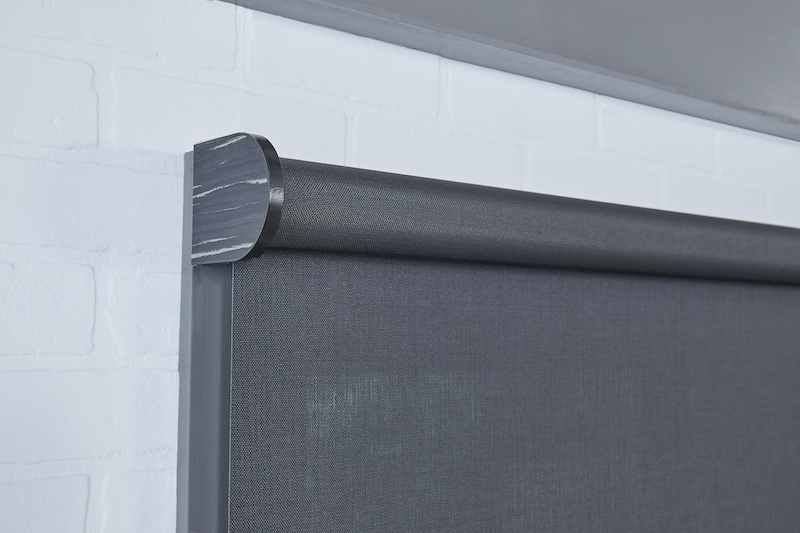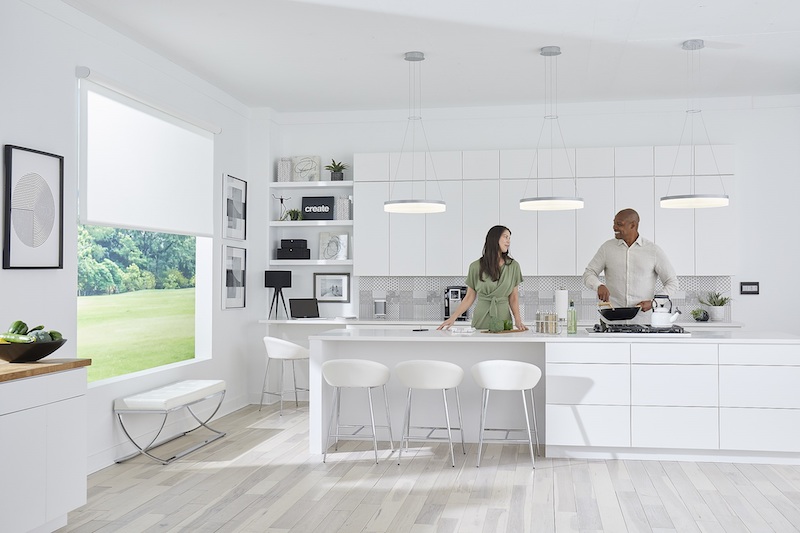Every home has windows and lots of them. For integrators, windows represent an attractive and profitable way to further enhance the convenience, comfort, and style of a home. In this era of automation and innovative technology, motorized window shades have emerged as a game-changing solution.
As the demand for smart solutions continues to rise, integrators have a unique opportunity to tap into the market for motorized window shades. They help to increase the value of a home while adding a substantial profit margin for integrators. However, selling motorized window shades requires more than just offering a product — it necessitates a strategic approach to effectively meet customer needs and drive sales.

For some integrators, the idea of selling motorized shades seems more fitting for interior design businesses. Yet, there’s something that installers know that designers and architects don’t: how to integrate technology.
Shades are a natural fit in the world of AV. Behind the fabric options, motorized window shades are, at their core, another piece of the smart home experience. Homeowners want to bring their shading under the same control as their lighting or home control system. Shading is also a component of human-centric lighting, a growing trend for homes looking to reap the productivity, wellness, and lifestyle benefits of circadian lighting. In fact, CEDIA’s 2022 Integrated Home Market Analysis listed lighting and shading among its top categories experiencing the most growth.
“Most AV dealers don’t realize the amount of [profit] margin that’s in shading,” said Shane Silloway, president of Shade Partners. “It has a huge profit center that they’ll see right away, unlike other AV products. Hypothetically, if you sell $100,000 job, and you’ve got a decent multiplier, you’re going to make $50,000.”
For integrators looking to tap into shading, here are some key strategies from experienced dealers that can help AV integrators maximize sales and provide exceptional user experiences:
- Take Advantage of Being Through the Door
Residential installers are in the sweet spot when it comes to offering shading to their customers. “You’re already in the home,” said Dave Wexler, senior director of sales and marketing at EOC Audio. “So, the hardest part — finding customers — is done.” As you plan out home AV projects with existing customers, take advantage of that time to also remind them that you do shading.
“AV integrators are in there much earlier than even an interior designer or a window covering dealer,” Silloway added. “At the beginning of the project, just simply say, ‘Hey, we offer shades. I don’t know if you need them, but I can run a quote if you’re interested.’ That’s how so many of our dealers still approach it.”
In addition to having shading listed on its website, EOC Audio recommends that shading is listed on any leave-behind or email marketing materials.
“If you do a lot of business with builders, make sure they’re also aware that you offer shades,” Wexler noted.
“A traditional window covering dealer is typically in too late,” Silloway confirmed. “They’re not going to find out until the house is already built. At that point, everything’s already closed up and no wires can be run, which means they can only offer manual or battery-operated options.”
- Listen to the Customer
For some installers, shades can be an overwhelming proposition because they’re very custom. For those who are hesitant to get started, Silloway advises that installers lean into the skills that make them great at AV — listening.
“Break it down to the simplest denominator by listening to the customer,” Silloway said. “What’s the experience they’re wanting? Do they need to completely block out the sun or are they looking for privacy and light filtering? Maybe they want a human-centric lighting system that ties their lighting, shades, and control system all together. Find out their needs and go from there.”
- Focus on Control Compatibility
When it comes to deciding on a shading system, the consensus is that installers should start with the one that’s compatible with their chosen AV or lighting control system, such as Vantage LHUMAN human-centric lighting control solution, which harmonizes natural and artificial lighting to create the perfect lighting environment to fit the homeowner’s lifestyle throughout the day.
“You’ll save yourself a lot of time if you already know it’s a shading system that will integrate and play nicely with the control system you’re familiar with,” Wexler said.
- Align Needs with Features
Like any audio, video, or control solution, shading brands each have their own features that make them unique. It’s a good idea to learn these features and how to align them with what the client is looking for. For example, if the home wants motorized shading in a guest bedroom or bathroom, a controller may not be ideal in those spaces. Legrand Shading, for example, offers a patented manual override feature for its automated shades so anyone can open and close them, with or without a controller.
Manual override control is also great in the event of a power outage. According to the U.S. Energy Information Administration, customers experienced an average of 1.3 interruptions and went without power for four hours in 2016. That number has only increased with extreme weather conditions in several states putting a heavy demand on electricity use. Bearing the expected electricity shortfalls that are predicted by North American Electric Reliability Council (NERC) throughout most the U.S in the coming years, integrators can help manage any limitations this might cause for homeowners. This will allow homeowners to manually raise or lower the shade to the desired position in any situation.
- Start with Three or Four Fabrics
Don’t try to know all the fabrics. When first starting off, start with small selection of go-to fabrics that will work in just about any space. Silloway likes to choose one neutral and one darker shade (one for blackout and the other light-filtering.) “It’s the perfect combo if you need to do shades in the bedroom and want the same fabric in the living room — same style, different needs,” he said. He also recommends having a decorative fabric choice in the mix for clients who want something that’s a little different and pops a little more. Need both? A dual shade system allows the installation of two shades on a single window for greater flexibility in light management.
- Find the Shade Champion or a Partner
When adding shading to your business, the best approach is to work toward having a single person on staff dedicated solely to learning and overseeing shading projects. “Integrators don’t have the confidence in shade selling as they do in selling audio, video, distribution, or control,” Wexler said. “You have to have somebody who is really into it and gets it. It’s really its own revenue stream — almost like a business within a business. If you really want to capture those sales, this is the best way we’ve seen it done.”
The other alternative is to partner with someone who is already proficient in shading, like Shade Partners. Silloway himself has been in the business for 35 years, learning first from his father, who was a residential window covering supplier. He knows everything there is to know about shading and now, through his company, partners with AV integrators, builders, architects, interior designers, electricians, lighting designers, and window covering professionals. “If you want us to just handle your installations, we’ll do your installation,” Silloway said. “If you want us to sell it for you, we’ll sell it, too. And there’s still a great profit margin.”
- Measure Three Times
Once the installer arrives at what the client wants, then it gets down to the nuts and bolts of shading — measuring. Measuring, like anything else, takes practice and is where mistakes most often occur. For that reason, both Silloway and Wexler recommend measuring three times. Get comfortable using a steel tape measure or a laser measuring device, starting with the windows in your own home. It’s also key in this process to know what manufacturer tolerances, i.e. the amount they deduct for an inside mount shade, which can be anywhere from 1/8 inch to a ¼ inch. “That way, you know when you take your finished dimensions, you know exactly what you’re getting,” Silloway said.
Shade with Success
The future is bright for selling motorized window shades. While initially it can be daunting, it can be an incredibly lucrative venture for installers. Start with a solid foundation. Identify someone who is prepared to take on the role of shading champion. That person can stay committed to overseeing the entire process, from training to sales and installation.
Because there are so many options and possibilities, keep it simple in the beginning. Pick solutions that are compatible with the chosen AV control system for a smooth installation experience, look for shading features that will provide a broader use case across the home such as manual override, and select a few fabrics that will fit almost any space. Finally, measure, measure, and measure again. By embracing these best practices, AV integrators can ride the wave of demand for motorized window shades and make it a shining addition to any business repertoire.








